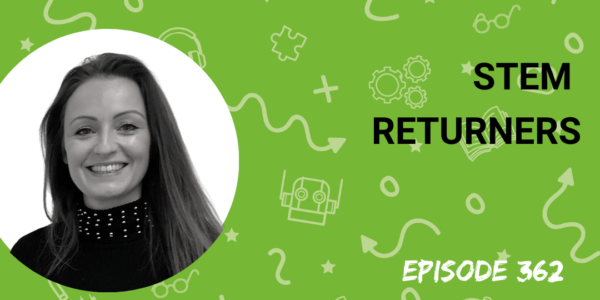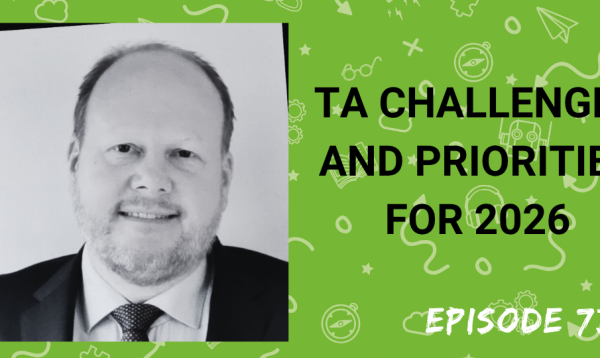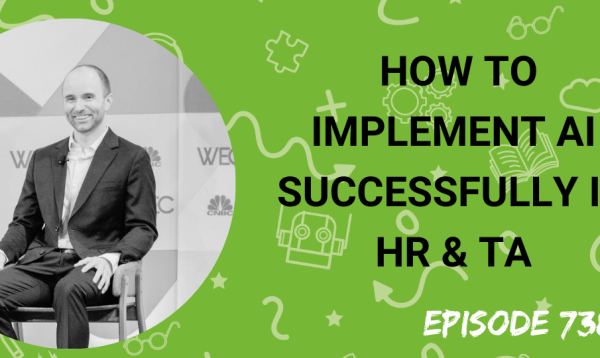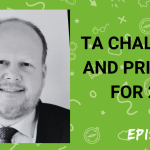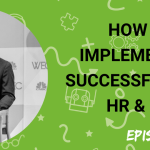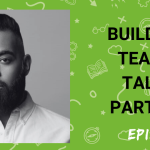I’m publishing this episode the week of Women in Engineering Day. Skill shortages in STEM professions continue to be a big problem for many employers, and diversity is also a significant issue. However, research shows that there is a diverse and highly qualified workforce of STEM professionals who are currently struggling to return to work after a career break. So why is this the case, and what should talent acquisition professionals do to address the situation?
My guest this week is Natalie Desty, Founder and Director of STEM Returners. STEM Returners is a programme to help employers recruit, develop and retain the best available talent, and to enable highly qualified and experienced candidates to re-start their careers. Natalie has some excellent insights and advice to share.
In the interview, we discuss:
▪ Why Natalie started STEM Returners
▪ The underrepresentation of women in engineering
▪ The STEM Returners Index
▪ Insurmountable barriers facing returners
▪ Why the recruiting process isn’t working
▪ Conscious and unconscious bias
▪ Job adverts versus job specs
▪ Advice to talent acquisition
Listen to this podcast in Apple Podcasts
Transcript:
Matt Alder [00:00:00]:
Support for this podcast comes from E6. For 25 years, E6 has been the preeminent peer networking and independent information source for corporate executive recruiting leaders worldwide. Featuring members from around 100 of the leading employers in the world, it is the one stop shop for trusted networking with peers, for benchmarking and for team development. Find out more about membership@www.e6.org. That’s WW and E6 is spelled E S I X. Or buy their book Leadership Recruiting on Amazon.
Matt Alder [00:00:58]:
Hi everyone, this is Matt Alder. Welcome to episode 362 of the Recruiting Future podcast. I’m publishing this episode the Week of Women in Engineering Day. Skill shortages in STEM professions continue to be a big problem for many employers and diversity is also a significant issue. However, research shows that there is a diverse and highly qualified workforce of STEM professionals who are currently struggling to return to after a career break. So why is this the case and what should talent acquisition professionals do to address the situation? My guest this week is Natalie Desty, Founder and Director of STEM Returners. STEM Returners is a program to help employers recruit, develop and retain the best available talent and to enable highly qualified and experienced candidates to restart their careers. Natalie has some excellent insights and advice to share. Hi Natalie and welcome to the podcast.
Natalie Desty [00:02:04]:
Thank you very much.
Matt Alder [00:02:05]:
An absolute pleasure to have you on the show. Could you just introduce yourself and tell us what you do?
Natalie Desty [00:02:10]:
Yeah, of course. So I’m Natalie Desty and I run a company called STEM Returners. So Stem Returners is all about returning people after a career break, obviously within the STEM industries.
Matt Alder [00:02:19]:
Fantastic stuff. And tell us a little bit about your story and how the company started.
Natalie Desty [00:02:24]:
Okay, So I spent 12 years in recruitment actually prior to starting STEM Returners as a director for a business operating in maritime. So I knew the recruitment sector well and I knew there was an issue within people trying to return after a career break. So I started doing a lot of work with women’s engineering society and because I was in maritime, the Institute of Marine Engineering Science and Technology and just started becoming really interested in why certain people were struggling through standard recruitment channels. So alongside that role I was also, and still am, people program chair of something called UK Nest, which oversees the UK Naval defence industry. And at that point we were looking at ways that we could increase diversity within naval engineering, which, believe it or not, is even worse than standard engineering. So females in engineering as an example Depending on what report you read, are 10 to 12% in naval, then more like 5%. So we’re looking at that. But also kind of these advanced skills gaps and how we could bring people different applications through. So I created a returners program as a pilot for those organizations. So organizations like BA Systems and Babcock, we created a pilot in 2017. It was really, really successful and we just kind of started doing more pilots and stemreturners organically grew from there. So other companies saw what we were doing, and then STEM Returners became a company in its own right.
Matt Alder [00:03:52]:
Fantastic stuff.
Matt Alder [00:03:52]:
And I want to kind of dive.
Matt Alder [00:03:53]:
Into what you do a little bit more.
Matt Alder [00:03:55]:
But before we do, you’ve just done.
Matt Alder [00:03:56]:
A piece of research, sort of this particular industry. Tell us about the research and how it came about.
Natalie Desty [00:04:01]:
Okay, so we know that there’s an issue with people returning, and obviously we work with a huge amount of returners. So we’ve got about four and a half thousand returners who are registered with us and currently looking. So we knew that there was an issue, but I guess we wanted to quantify it a little bit and really kind of be able to say to industry, there’s a real problem here. So what we did is ask those returners who were either had currently or recently returned to some of our host companies that we’re working with or were still trying to return and really trying to understand from their perspective what the barriers were, so that hopefully us and other organizations within STEM could start removing some of those barriers and making it easier.
Matt Alder [00:04:44]:
Interesting stuff. So talk us through the industry a little bit more. What are the issues in terms of recruiting and what are the issues in terms of people returning to stem?
Natalie Desty [00:04:53]:
Well, there’s a massive skills gap, particularly within engineering, and that’s quite well documented by the Royal Academy of Engineering. The, Iet all of the kind of, you know, big professional engineering institutes recognise the problem, as do the companies working within engineering, realise that, you know, some of their roles they just cannot fill or they stay open for 612 months with no applications. With returners, the barriers of them returning are genuinely insurmountable. These people apply for hundreds of vacancies and never even see receive a response. So, you know, and the key issue here is these returners are being filtered out at the initial stages, so they’re not actually ever hitting the hiring manager’s desk. So these people are, you know, trying to return, not being successful. And I think, you know, I think the key reason, Matt, is they’re being compared to candidates without a career Break. So you know, if you’re a hiring manager and you have five CVs to review, five, four don’t have a career break and one does that person viewed as potentially having out of date skills, they kind of get filtered out of the process at the initial stages. So that’s one issue. Another issue is a huge lack of diversity in stem. Interestingly, it’s those diverse candidates that are getting filtered out. The high majority of returners, I think when we surveyed 51% of returners were female, which bearing in mind 10% of engineers are female, is obviously much higher proportion of females and 38% were from ethnic minority backgrounds. Ethnic minority background candidates working in engineering is 6%. So you know, you can see that actually that that return of talent pool is incredibly diverse.
Matt Alder [00:06:38]:
Kind of sounds like a no brainer. And it’s interesting that you’ve done sort of so much research into what’s going on, I suppose to sort of go through research a little bit and shine a bit more light on this for people. What were the reasons that people are taking career breaks?
Natalie Desty [00:06:50]:
So there’s lots. And what I always say is there’s no such thing as a standard returner and people take career breaks for all different reasons. But interestingly we found in the research only 12% of people have taken a break for what they deemed as a personal choice, essentially travel the world or something. So the key reasons people take breaks are a big one and probably the biggest is childcare or caring responsibilities. So actually I think the term carers sums it up much more than kind of maternity leave because it’s not just childcare, it’s often elderly care as well, or ill relatives. So I think carers is a large group. Health is another big one, particularly long term health. We have a lot of people returning after beating cancer and similar things like that. Also mental health actually we see quite previous high level executives who are returning after mental health. Redundancy is another really big one and that’s been hugely impacted with COVID So the amount of people obviously who have been made redundant certainly within certain sectors has increased hugely. And another big one is relocation. So we work with candidates, we work with lots of different avenues to find these candidates. We work with a lot of charities, things like refugee charities as well. And we find that people trying to transfer their skills from other countries find it almost impossible, you know, and we’re talking about a bridge engineer, you know, bridge engineer who has experience of building a bridge in another part of the world can’t transfer those skills to the uk, even though the bridges are pretty similar. So, you know, it’s just, it’s just, it’s really difficult to understand why it’s so difficult for these people. And they have, you know, software engineers is a good example and the software that they’re using is the same, but they’ve been doing it in another country yet find it absolutely impossible to transfer, transfer that here.
Matt Alder [00:08:50]:
So we’re talking about a group of highly skilled, diverse people who are trying to get back into an industry that has massive skill shortages and a huge problem with, a huge problem with diversity. Someone who’s a, who’s a recruiter yourself. What are the issues that people have in the recruitment process and what sort of perceptions did a recruiter is having? Is it recruiters that are the problem? Is it the process that’s the problem? What are you seeing?
Natalie Desty [00:09:16]:
I think there’s a, there’s a few things but what we tend to see most of the time is returners are being filtered out at application stage. And had a really good example of this with the first company we ever worked with. So I was working with a single mum, so she’d taken a five year career break to raise her child and her skills before that she was in naval architecture, which is a very specific skill short area. And obviously she was a female candidate, so she was one of that 8 to 10% as well. And she wanted to apply for a partner organization that we were working with. And she said, natalie, there’s no point me applying. I’ve applied for that company three times. A, I’m going to look like a stalker and B, they just aren’t interested in me. And I said, you know, I’m sure there’s, there’s something going on here. Your skills are exactly what they’re looking for. So I phoned the hiring manager and I said, oh, this is a weird one. This candidate’s applied for you three times but she’s been rejected. You know, but to me she looks really suitable. So I sent her CV and he phoned me back and he said, natalie, I’ve never seen this candidate cv. And that’s when I realised there is hiring manager bias. Absolutely. But there’s an issue with these people being filtered out before they even get there. So she was taken on the returners program. She’s been promoted three times, so she was probably our first returner placed in 2017. She’s been promoted three times and she’s an absolute star. And she is a candidate who had tried so hard to apply for this particular company. And had given up thinking that actually they’re not interested in her skills, you know, and I guess before I would have thought, oh, you know, that’s the hiring manager being biased and not taking her forward because she’s had a career break. But in actual fact he’d never even got the cv. So what’s happening is they’re being filtered out at application stage. Now I think a key reason for that is say an organization, you know, lot of, probably majority of engineering organizations work with recruitment consultants or recruitment agencies. And you know, if you think actually as a recruiter I’ve got to send my best three or top three CVs, you know, you can’t send everybody obviously who applies. I think the career break candidate gets filtered out at that stage. There is unconscious bias, you know, there is unconscious bias that, well, we all have unconscious bias. But you know, I think assumptions are made about when somebody has a career break and whether they have had a deterioration of skills. And you know, eventually, as I said, these candidates just stop applying. So they try really hard and they stop applying and then they go and do something else or often we find returners have managed to return and they’re grateful to return but they’ve returned in a much less capacity. So we’ve just placed a project engineer who had managed to return after a three year career break into engineering, but she’d managed to return into admin and she was grateful, she was grateful to have a job but you know, part of this is returning them back to where they should be. So she’s now a project engineer with another partner organisation, you know, back to doing what she’s trained to do.
Matt Alder [00:12:23]:
So talk us through a little bit about what your organisation does. So how do you help these candidates and how do you help the hiring organisations?
Natalie Desty [00:12:31]:
Yeah, so the key thing is removing those barriers. And you know, really the biggest barrier is just making sure that these returners are viewed by the hiring managers because they just don’t seem to be getting through the process. So what we’re trying to do is strip all of that kind of lengthy recruitment process away. We partner with an organisation, they let us know what skills they’re looking for. They work with hiring managers that they know are going to be able to provide additional support and then, you know, really we just provide that bridge between the returner and the hiring manager. Returners are low confidence by nature, you know, so they’ve often had a lot of rejections and knockbacks. So we work with them to make sure that they, you know, they’re in the right space to start this 12 week placement and that they have the support that they need. So we provide coaching support. They get an industry mentor through Women’s Engineering society and that 12 weeks is a period of time where they can get there, you know, increase their skills and knowledge, get themselves up to speed and then at the end of that they always have an opportunity to get a permanent position. So we’d never work with an organisation that was looking just to provide somebody work experience, because although work experience is valuable, the returners end up in exactly the same position at the end of that. So there’s always the opportunity for a permanent role. And actually of all programmes, of 186 engineers we’ve returned now, 96% of those have all gone into permanent work at the end of the placement.
Matt Alder [00:14:03]:
Fantastic stuff. I mean, that’s amazing and absolutely brilliant that you have an organisation doing that. This is an issue that has, it seemed to come up time and time again and it’s something that I’ve kind of experienced within my own family and friends, this kind of bias against people who want to return to their career and the incorrect assumptions that are made. And it just does seem crazy at a time when there are such skill shortages and finding experienced talent can be. Can be very, very difficult. What would your advice be to talent acquisition leaders, to HR departments, to employers in terms of how they can stop this happening and how they can sort of fully embrace this amazing talent pool?
Natalie Desty [00:14:45]:
So I’d definitely say firstly to include returners in your shortlist. I think if you are looking to send your top three or five to your client, actually have that conversation with them up front and say, would you be interested in seeing somebody after a career break and make sure that they’re included in your shortlist? I’d also really challenge hiring managers. You know, hiring managers are very good at saying, you know what they want and giving you a long list unicorn candidate, you know, actually challenging some of those and some of that experience. And actually could somebody transfer? You know, if we’re looking, for example, for a mechanical design engineer as a returner to go into a shipbuilding company, we will always find a mechanical design engineer. They might not be from shipbuilding, they might be from aerospace or automotive, but they’ve got those skills that they can transfer in. And as well as returning, transferring is incredibly difficult as well. So I’d really get them to challenge and ask what skills are transferable. Also ask about your clients diversity initiatives. What are they doing in diversity? What are they doing to actively attract diverse candidates? Because obviously looking at returners and transferable skills is a really good way to do that. And then I think a big one is to create adverts and not job specs. If you look on any kind of job board, you will see a long list of technical job specs and no real adverts, kind of attracting somebody to work for a particular organization. Now, when somebody puts out a long technical job spec, bearing in mind I’ve said that these candidates are low confidence, they just don’t apply. They talk themselves out of it and think, actually I’m not suitable for that. I have people talking themselves out of suitability of a returner’s role, you know, and I probably have two or three bullet points of things that they’d need to have. You know, we don’t use job specs. We really just try and attract people with the right skills to come through.
Matt Alder [00:16:48]:
So, final question. Where can people find out more about what you do and where can they connect to you?
Natalie Desty [00:16:53]:
So our website is www.stemreturners.com. so there’s lots of stuff on there. There’s lots of stuff, lots of blogs about returners that have successfully returned and how they found it. I’m on LinkedIn as well, so it’d be great to link in with anyone. I’m just Natalie Desty and Stem returners is on LinkedIn as well.
Matt Alder [00:17:14]:
Fantastic stuff, Natalie.
Matt Alder [00:17:16]:
Thanks very much for talking to me.
Natalie Desty [00:17:17]:
No, Matt, it was a pleasure.
Matt Alder [00:17:19]:
My thanks to Natalie. You can subscribe to this podcast in Apple Podcasts, on Spotify or via your podcasting app of choice. Please also follow the show on Instagram. You can find us by searching for recruiting future. You can search all the past episodes@recruitingfuture.com on that site. You can also subscribe to the mailing list to get the inside track about everything that’s coming up on the show. Thanks very much for listening. I’ll be back next time and I hope you’ll join me.

